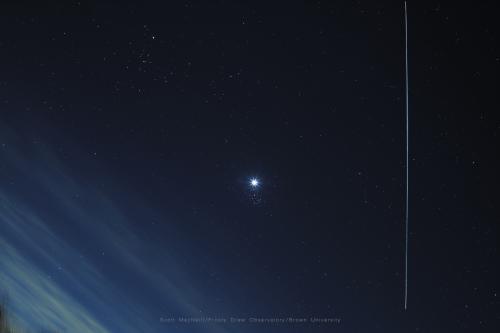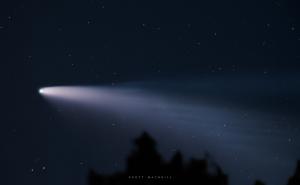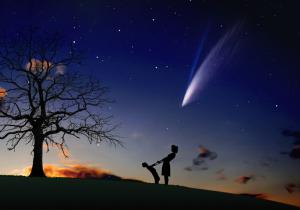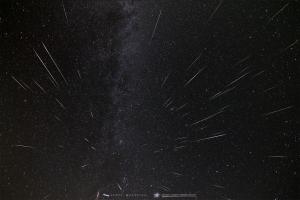Celebration of Space - July 24, 2020

The International Space Station passes over during the April 2020 Venus / Pleiades conjunction. Image Credit: Scott MacNeill
This past Thursday, July 23, 2020, Comet C/2020 F3 NEOWISE, which has been putting on a fabulous show for Northern Hemisphere sky watchers, passed Earth at its closest approach to us. On this date, Comet F3 NEOWISE was at a mere distance of 64,313,189 miles away. Which is just under 0.7 times the distance of the Sun from Earth. The comet continues to be naked-eye visible in the evening sky, though we have observed a slight dimming. Now that the comet has passed Earth, it should start to dim quite quickly, eventually dimming to the point where it is no longer naked-eye visible. There are a lot of unknowns in regards to comets, and NOEWISE is certainly an interesting comet. Let’s talk scenario here.
Comet NEOWISE has quite a large nucleus, at about 3 miles in diameter. It also survived a rather close perihelion (closest approach to the Sun) at a distance of 27,391,909 miles. These are some of the reasons that the comet became so much brighter than expected. We are also seeing activity that is usually associated with some of the great comets of the past including an embedded sodium tail, and striations in the dust tail (what appears as concentrated lines of debris). With all this said, Comet F3 could maintain its brightness longer than expected. Additionally, comet F3’s nucleus could fracture, which would propel the comet to a whole new level of brightness! Now this is generally best-case-scenario, and even if the comet fizzles out of naked-eye view next week, we have had a great show from this comet.
Regardless of what the comet does, dimming below naked-eye visibility does not render the comet unobservable. Comet NEOWISE should remain visible in binoculars and telescopes well into autumn if not longer. Then there’s always the chance that the comet will form a spectacular anti-tail, which is a tail that points back towards the Sun. A comet’s ion and dust tails are always on the opposite side of the comet than the Sun, this is because it’s the Sun’s solar wind that creates the tail, not the comet’s motion. As the comet leaves the inner Solar System, it will appear to chase its tail. An anti-tail does the opposite of this, and is a product of a very dense debris field that is left behind by the comet, dense enough to be brightly illuminated by sunlight.
At Frosty Drew Observatory and Science Center, we will continue to host special events for viewing the comet on every clear night that we can. These events are called A Night with Comet NEOWISE and will be posted to our events calendar sporadically. So check in frequently. Additionally, you can still catch a naked-eye view of the comet in the NW sky. It has moved into the constellation Ursa Major and is visible below the Big Dipper after 10:00 pm. Since the comet is rising higher in the sky, it is becoming more accessible to those without a low view of the horizon. You will need a clear sky in that direction to catch a view. So set out this weekend, if the sky is clear enough, and look below the Big Dipper after 10:00 pm and see if you can spot the blurry star with a faint tail that points upward and to the north.
Nightly passes of the International Space Station (ISS) continue this week over the US and New England. Though most passes are not exceptional, you will be able to catch a view of the ISS silhouetting Comet F3 NEOWISE, which will make for a nice added bonus. Here are some pass times for this week:
Fri, Jul 24 at 10:09 pm, starting in the NNW, rising to 17°, heading towards the NE
Sat, Jul 25 at 10:58 pm, starting in the NW, rising to 32°, and into orbital sunset
Sun, Jul 26 at 10:10 pm, starting in the NW, rising to 24°, and into orbital sunset
Mon, Jul 27 at 10:58 pm, starting in the NW, rising to 36°, and into orbital sunset
Tues, Jul 28 at 10:11 pm, starting in the NW, rising to 47°, and into orbital sunset
Wed, Jul 29 at 9:23 pm, starting in the NW, rising to 32°, and into orbital sunset over the E
Wed, Jul 29 at 10:59 pm, starting in the WNW, rising to 20°, and into orbital sunset
Thu, Jul 30 at 10:11 pm, starting in the WNW, rising to 62°, and into orbital sunset ← Best pass!
These times are for Southern New England and generally applicable to the Northeast. Note that most locations where the ISS will rise are near Comet F3 NEOWISE, and being that these coincide with times to view the comet, the opportunity is there! So put these times on your calendar and set out for views of the station passing over, and take a peek at Comet F3 NEOWISE while you’re at it!
At this time, we have three active meteor showers taking place. The Southern Delta Aquariids, the Alpha Capricornids, and the Perseids. Outside of the peak night of these meteor showers, activity will be fairly low. Though due to all happening together, you have a pretty good change of spotting several meteors overnight. At Frosty Drew Observatory, we have seen a lot of meteor activity as we are out looking at Comet F3 NEOWISE, about 30-40 meteors per night. Of all these showers, the Perseid Meteor Shower is the real banger! The Perseids will peak overnight on August 12-13, 2020, bringing upwards of 120 meteors per hour. We usually try to host an event at Frosty Drew, but that timeframe is the heart of wildfire season in the US, and though we don’t frequently get wildfires in New England, we do get the smoke of fires happening on the western side of the US. This usually makes for poor weather conditions to observe. Regardless, we will continue to offer up an event with the hope of a clear night. Regarding the global pandemic, we are unsure how this event will play out this year and will be in contact with the RI Department of Health and the RI Department of Business Regulation to determine what we can do. Visit the Persied Meteor Shower event page for updates on what we are doing. Until then, be sure to step out after the Moon sets and see how many shooting stars you can spot zipping by.
- Author:
- Scott MacNeill
- Entry Date:
- Jul 24, 2020
- Published Under:
- Scott MacNeill's Columns





